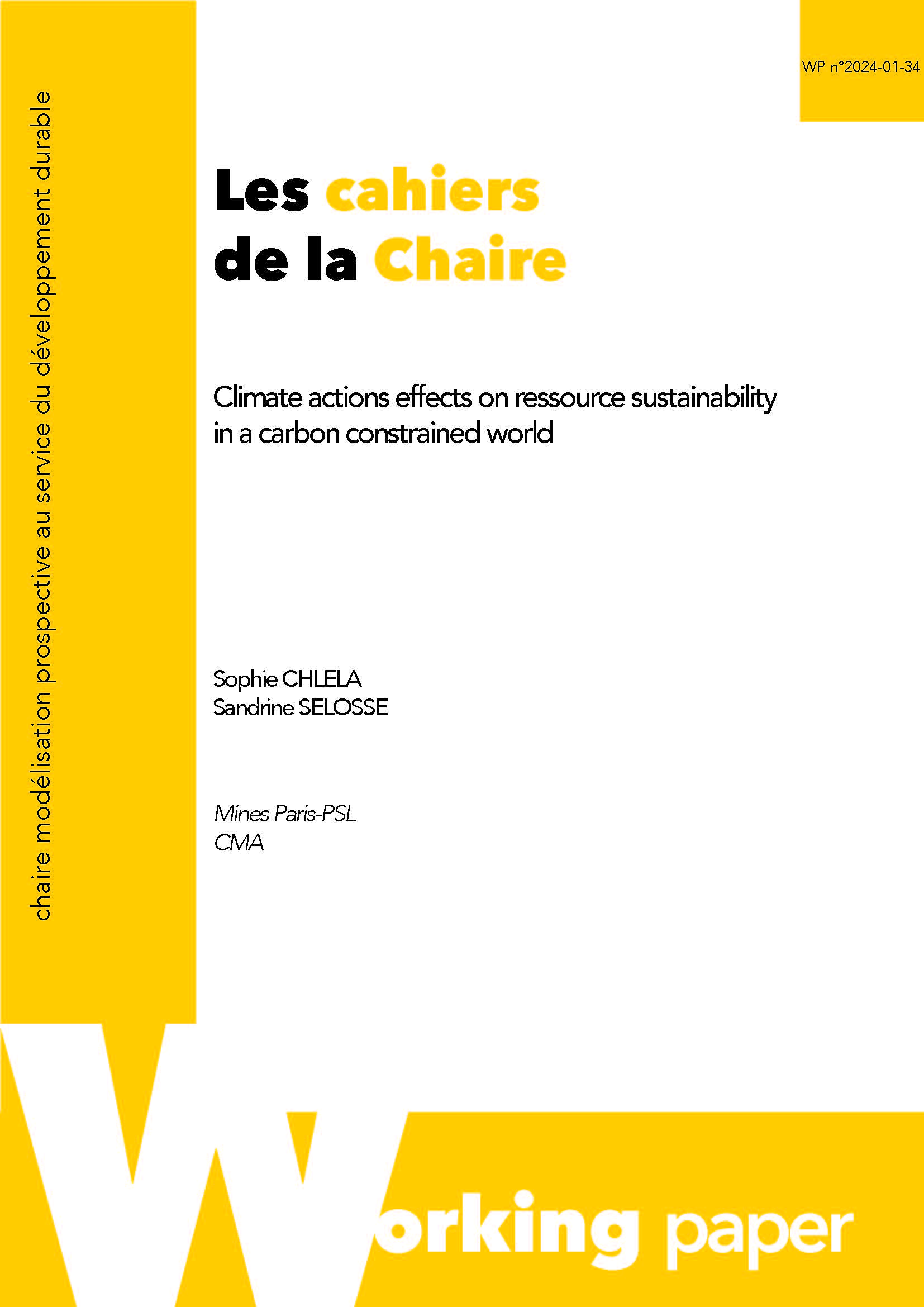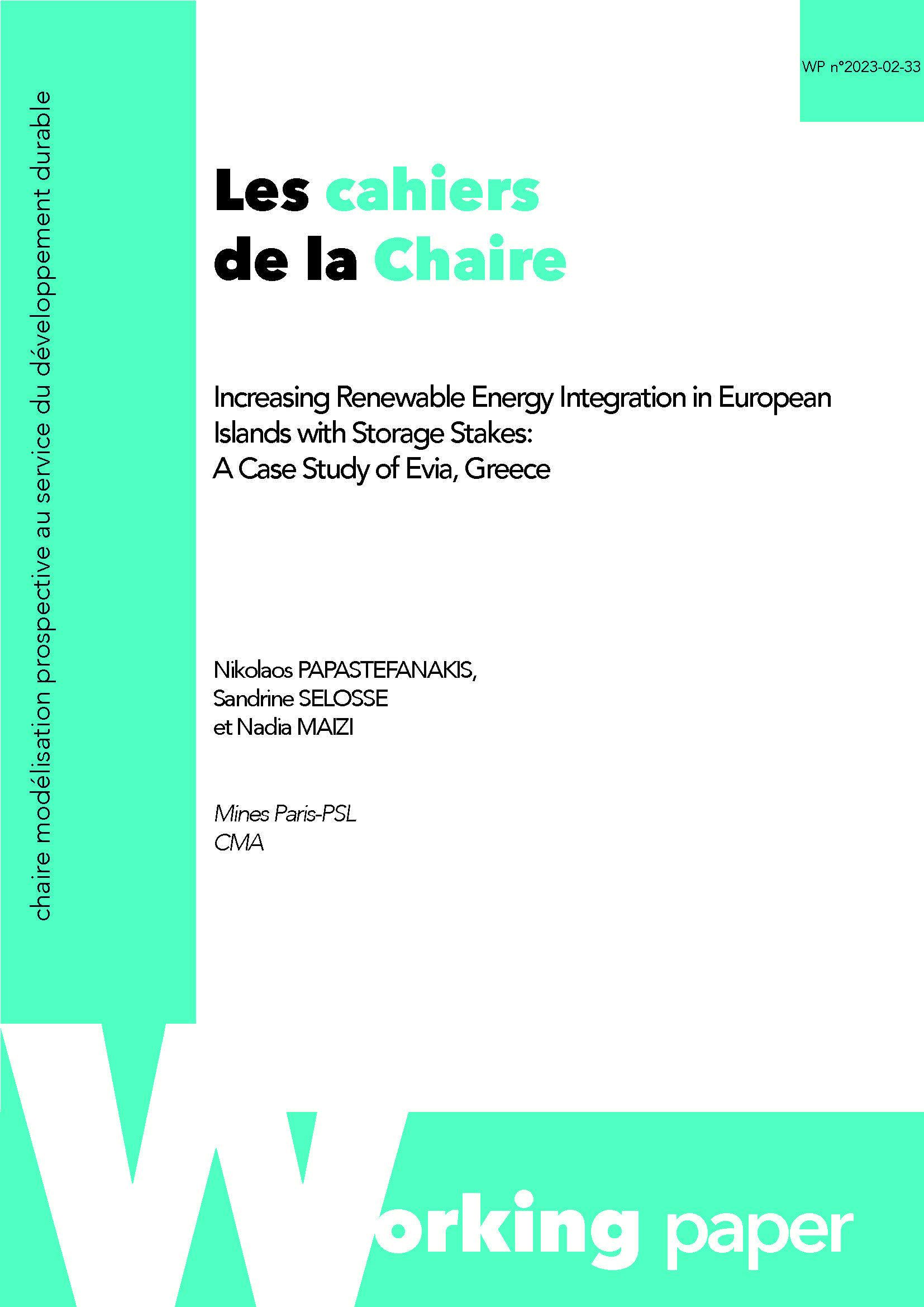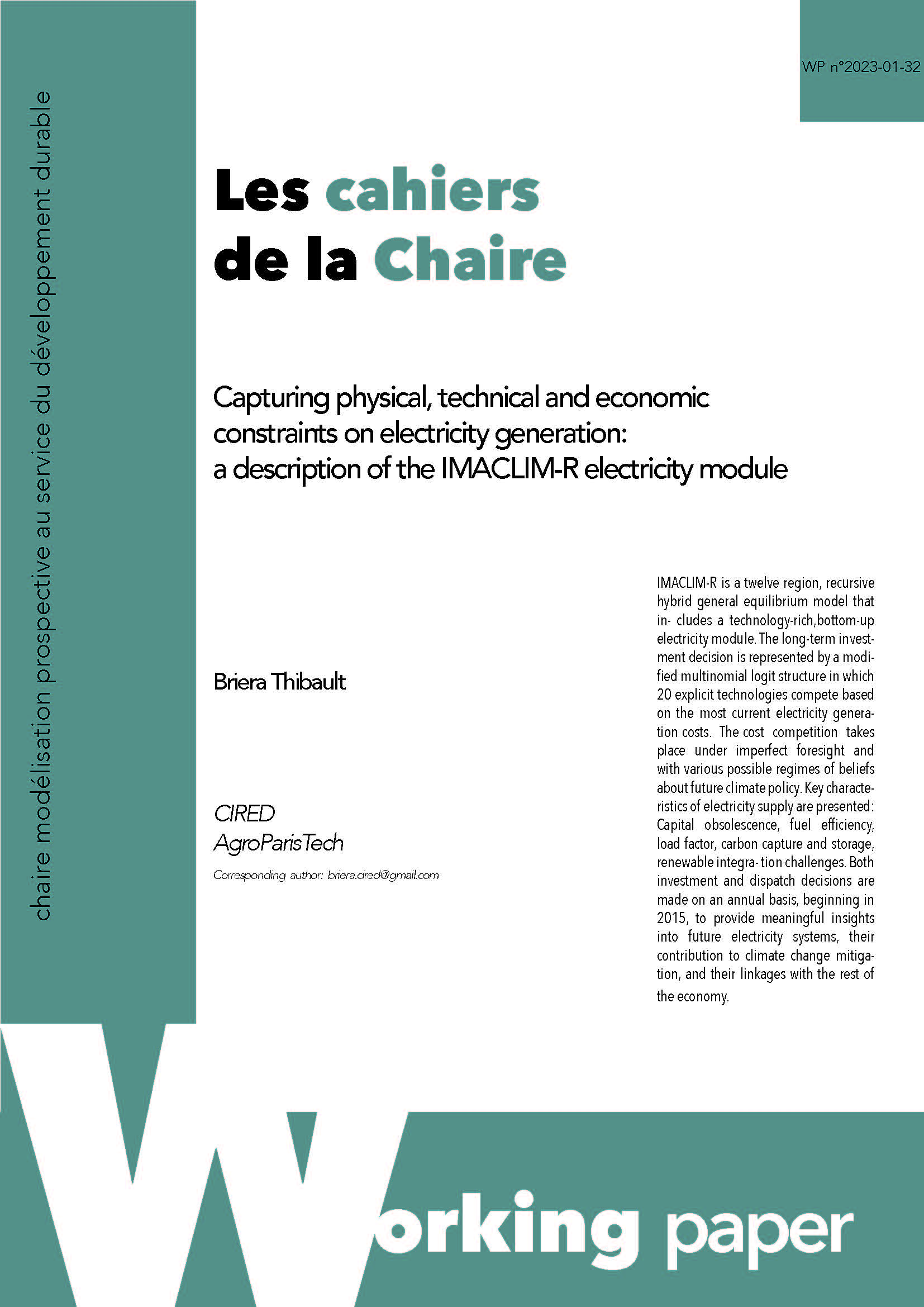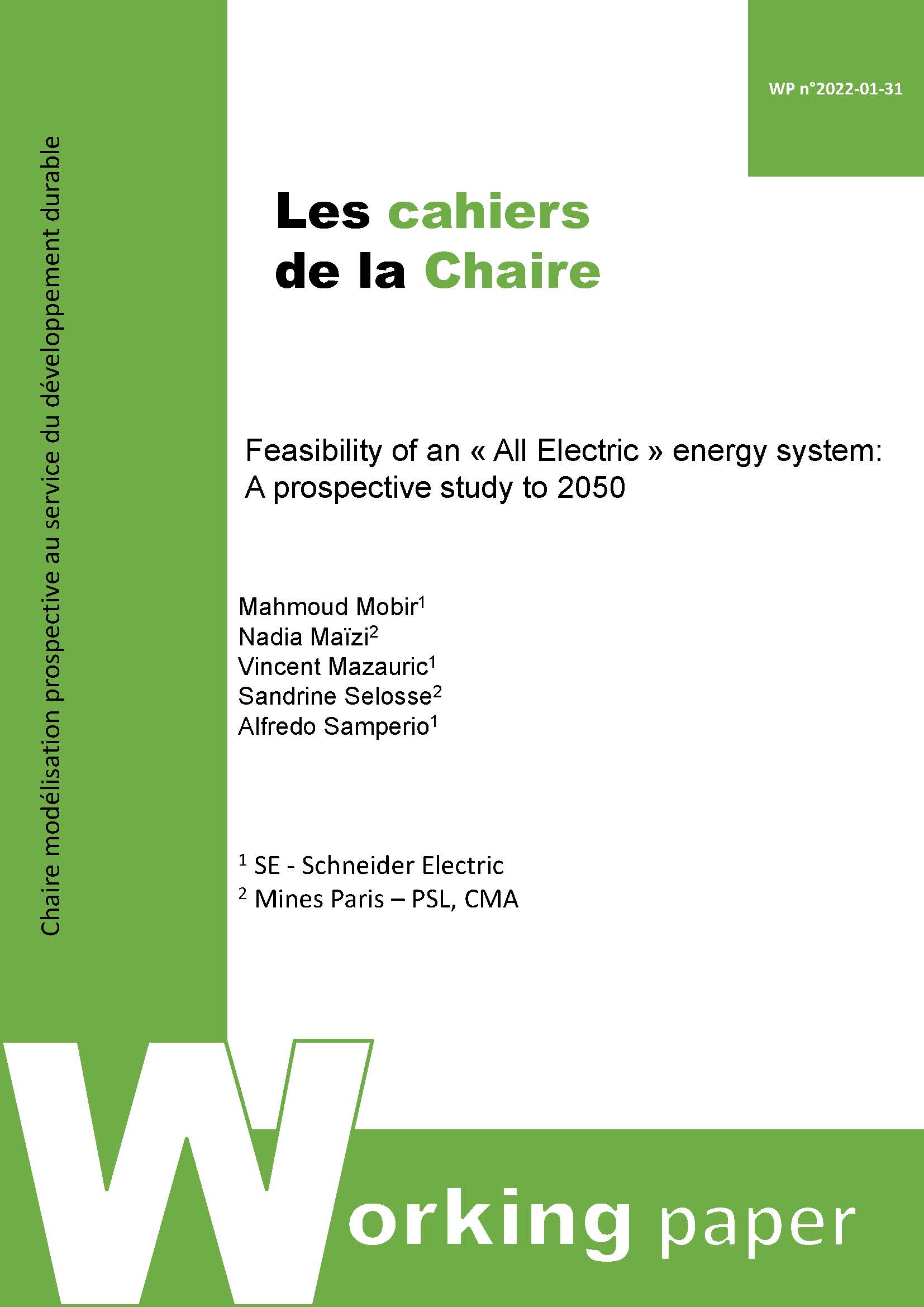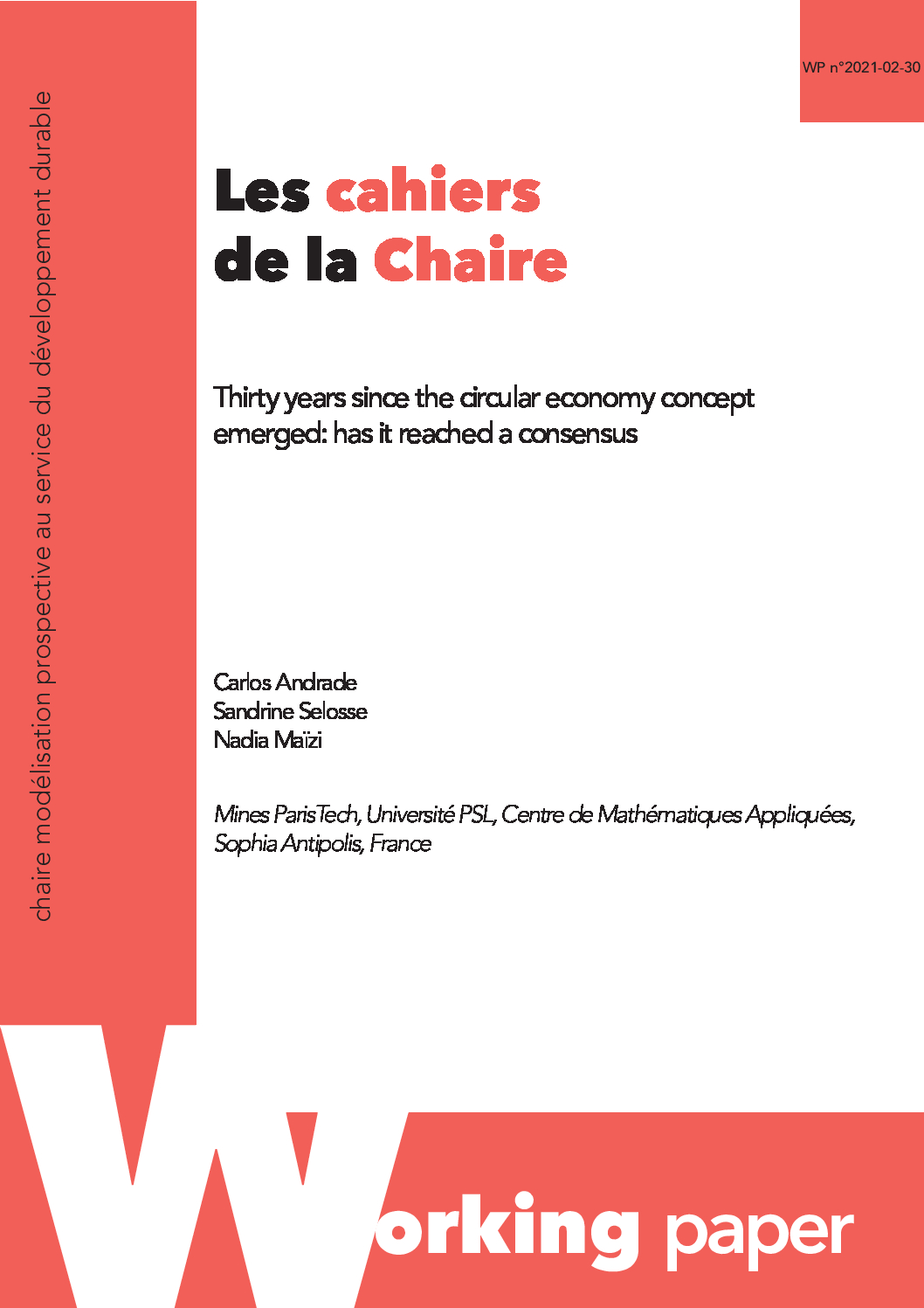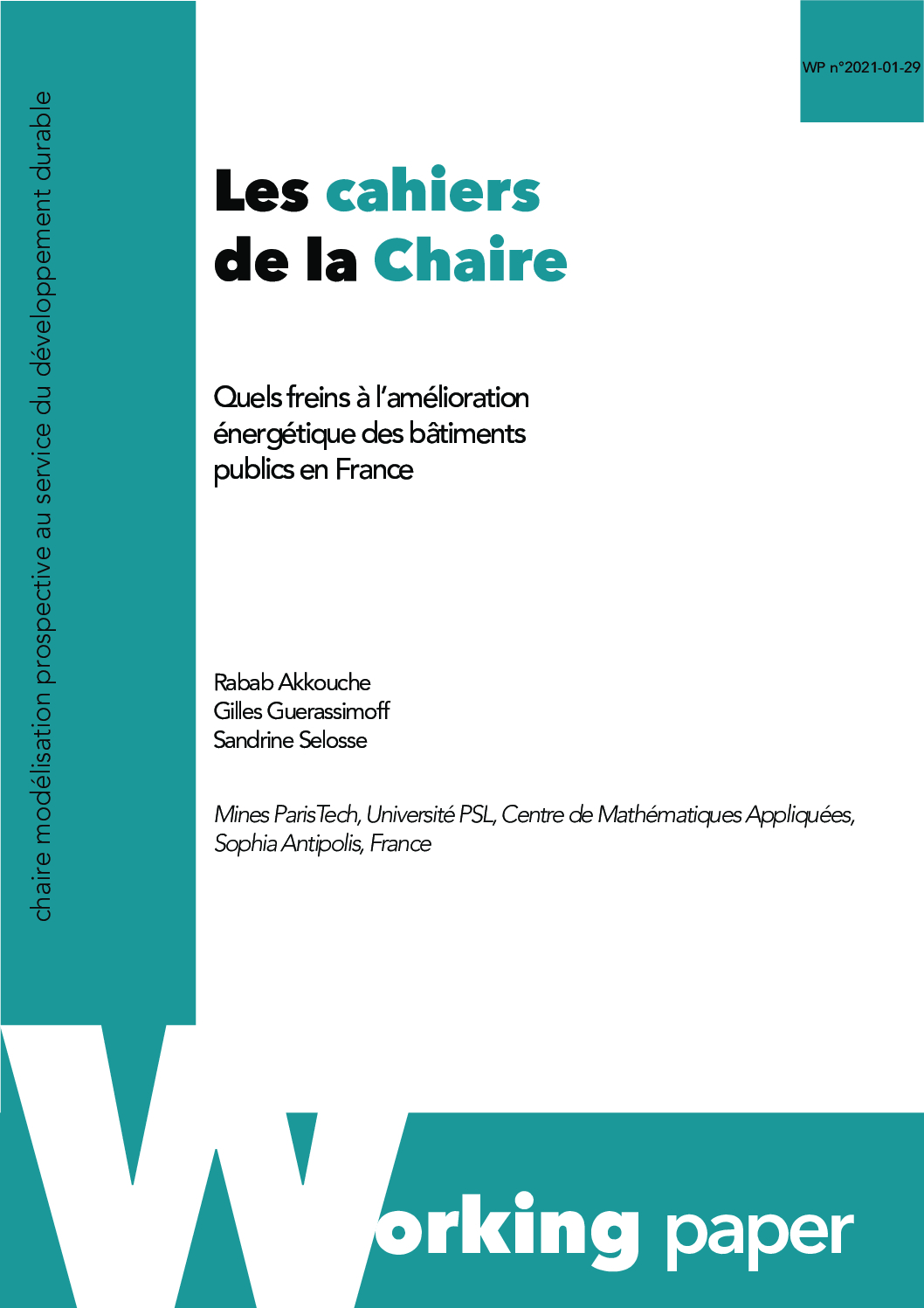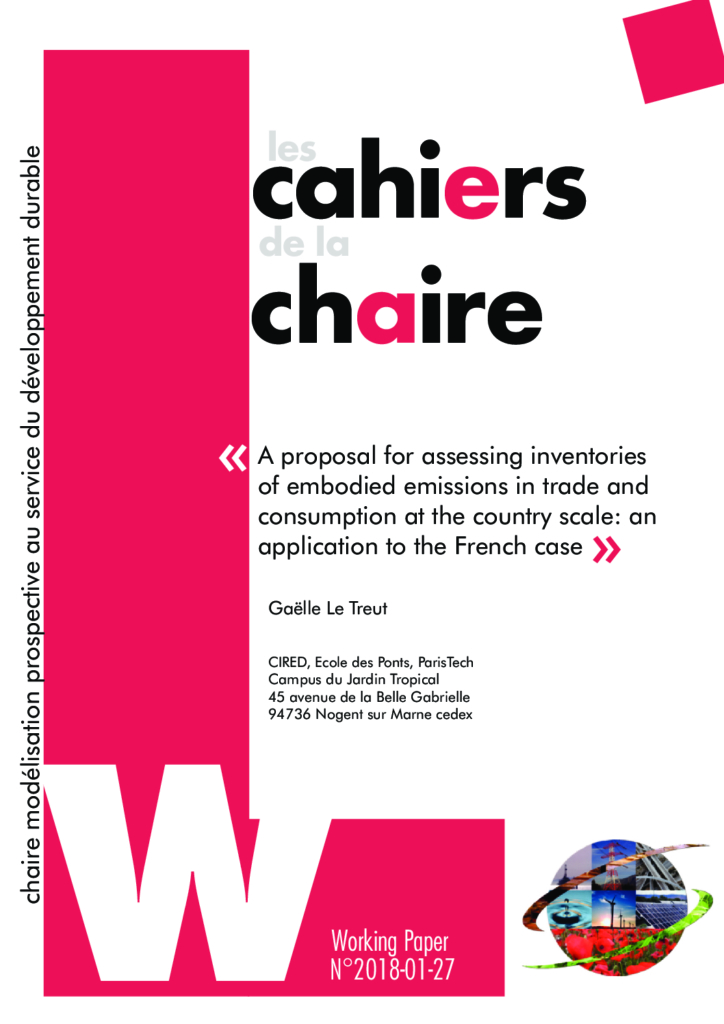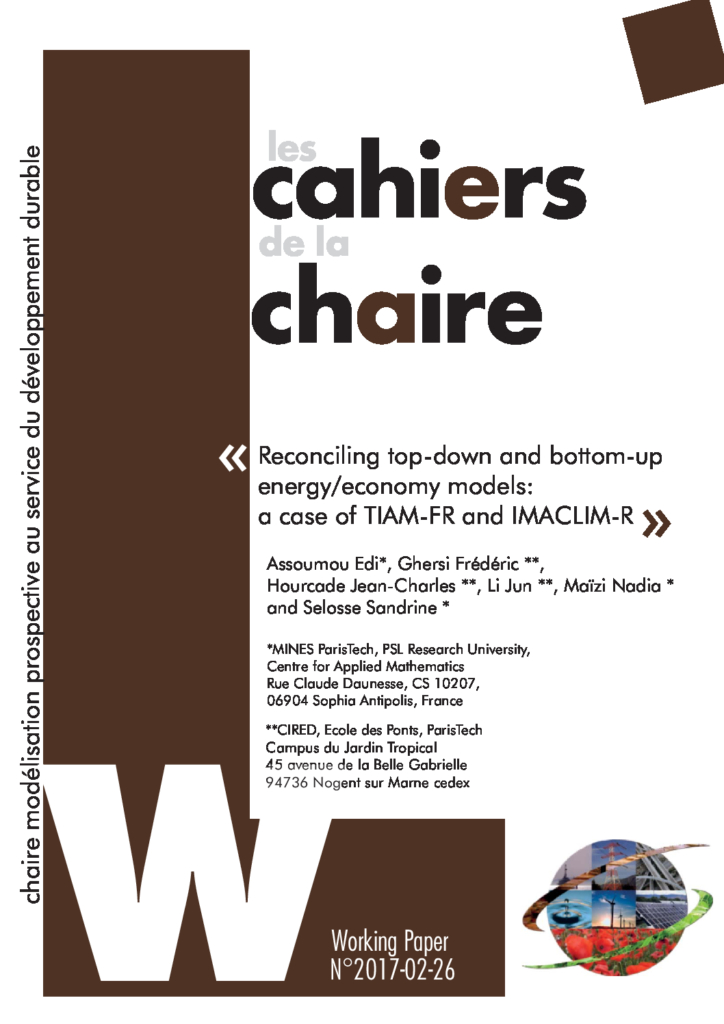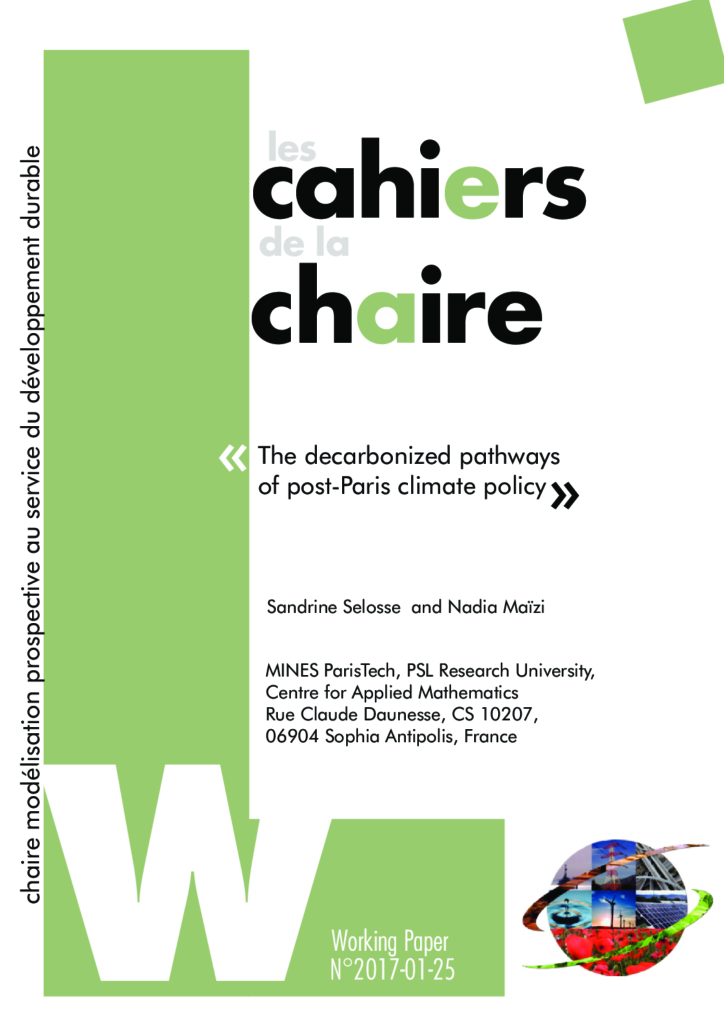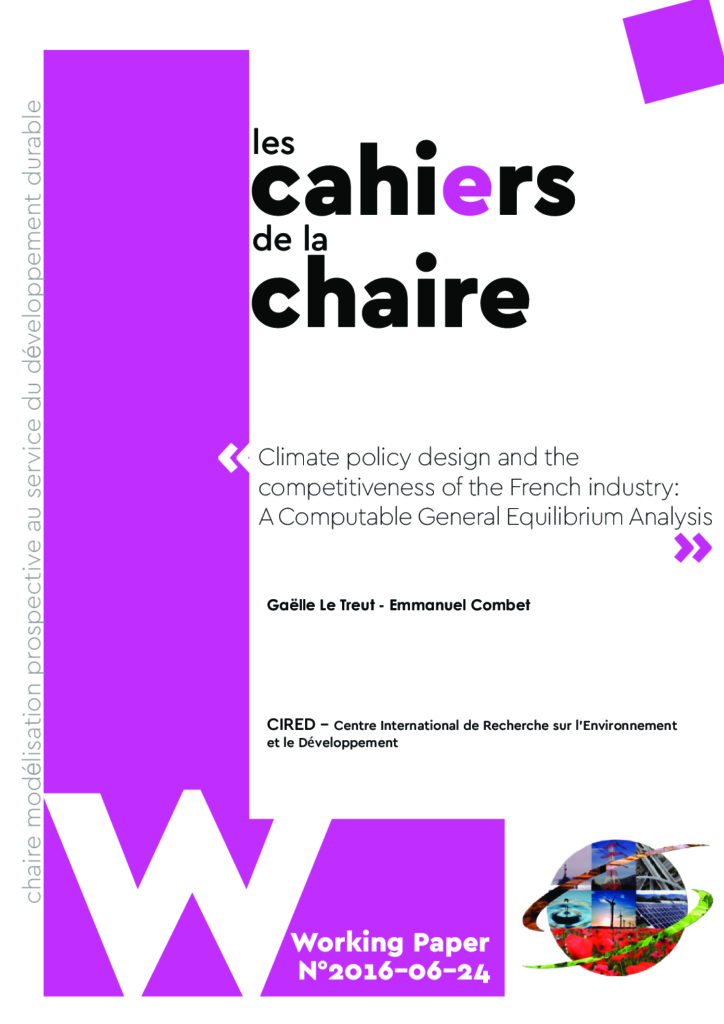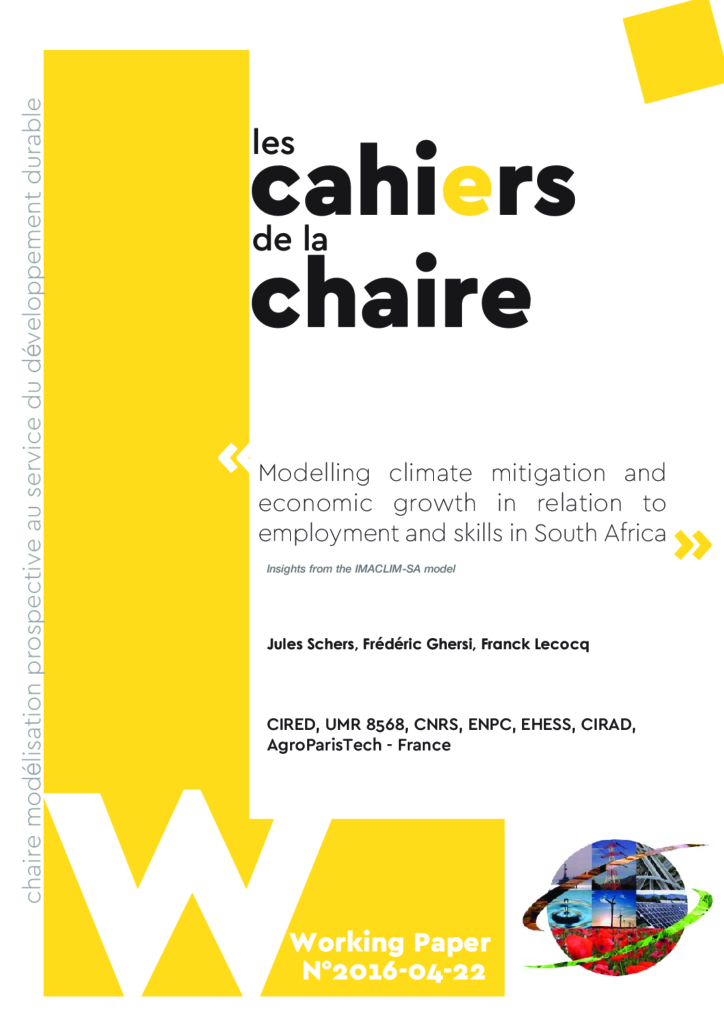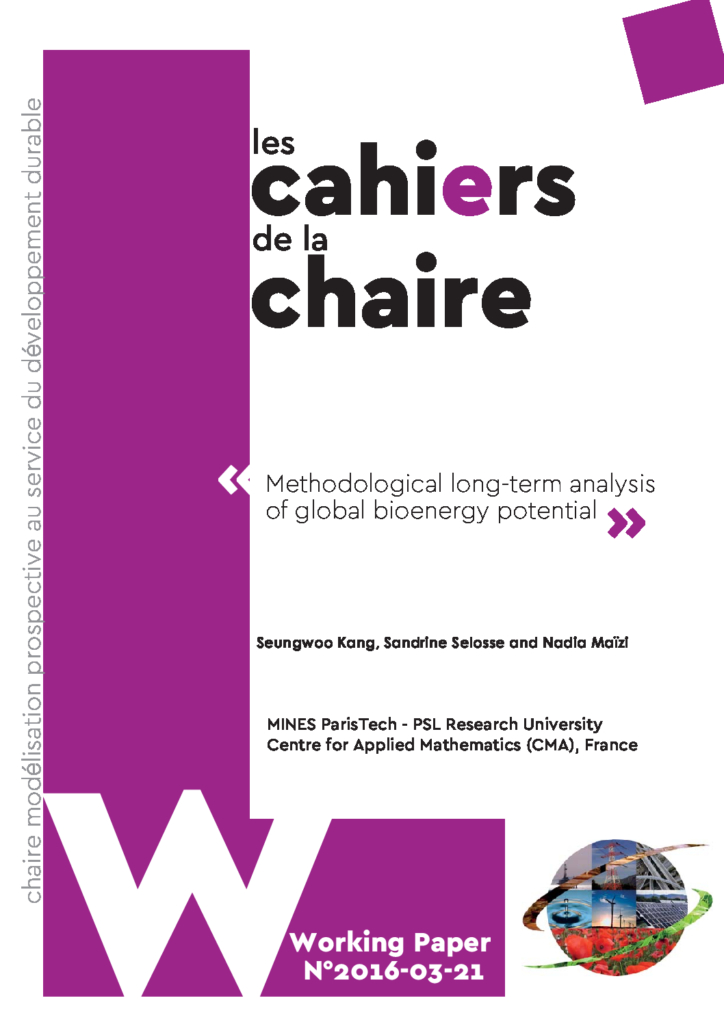Working Paper n° 2024-01-34
Sophie CHLELA, Sandrine SELOSSE, Climate actions effects on ressource sustainability in a carbon constrained world
This paper analyzes carbon dioxide removal (CDR), with a focus on Bioenergy Carbon Capture and Storage, as climate actions related to the Sustainable Development Goal 13. It examines this goal’s interlinkage to other UN goals such as SDG6 (water) and SDG7 (energy) in accordance with the concept of the water-energy-land nexus. To align the Nationally Determined Contributions (NDC) to the Paris Agreement long-term goal of net-zero emissions, the global energy system’s evolution is studied, using the global and regional outputs of the techno-economic optimization of TIAM-FR that incorporates various mitigation options including a disaggregated biomass representation. In addition, a water module is used to assess water withdrawals and consumptions. The analysis is made under three climate scenarios. Results show that bioenergy with carbon capture and storage (CCS) contributes to decarbonizing the energy mix (SDG7) even with sustainability constraints. Also, carbon capture and storage technologies are a plausible solution to keep the temperature limit at 1.5 degrees, but impact water use due to their use of water-intensive resources and technologies (SDG13 in trade-off with SDG6). The analysis shows that the Paris Agreement scenarios, both with and without temperature overshoot, increase global water use by 65% and 62%, respectively, by 2050 compared to 2020. Regionally, water-scarce areas like the Middle East and India exhibit similar patterns, whereas Africa shows lower water use compared to an NDC scenario by leveraging itsrenewable energy potential.
Working Paper n° 2023-02-33
Nikolaos PAPASTEFANAKIS, Sandrine SELOSSE et Nadia MAIZI, Increasing Renewable Energy Integration in European Islands with Storage Stakes: A Case Study of Evia, Greece
Prospective modelling is a valuable mathematical tool for supporting long-term strategic planning in the face of un-certainties associated with future events. This analysis is conducted by defining potential future trajectories – sce-narios, with the goal of exploring possible energy futures. The TIMES model is a partial equilibrium linear program-ming optimization tool that ensures the supply-demand equilibrium. This model identifies future expansion in-vestments that are required in the power system to meet forecasted demand while adhering to techno-economic and environmental constraints, all at the lowest possible cost. The energy systems prospective modelling results of the two demonstration sites (Procida and Hinnoya) showed that the proposed solutions of the GIFT project that offer flexibility and grid congestion relief, they promote also the further use of RES. More information about the mo-delling and the results can be found in Deliverable 2.4 (Chlela et al., 2021).
Working Paper n° 2023-01-32
Thibault BRIERA, Capturing physical, technical and economic constraints on electricity generation: a description of the IMACLIM-R electricity module
IMACLIM-R is a twelve region, recursive hybrid general equilibrium model that in- cludes a technology-rich,bottom-up electricity module. The long-term investment decision is represented by a modified multinomial logit structure in which 20 explicit technologies compete based on the most current electricity generation costs. The cost competition takes place under imperfect foresight and with various possible regimes of beliefs about future climate policy. Key characteristics of electricity supply are presented: Capital obsolescence, fuel efficiency, load factor, carbon capture and storage, renewable integra- tion challenges. Both investment and dispatch decisions are made on an annual basis, beginning in 2015, to provide meaningful insights into future electricity systems, their contribution to climate change mitigation, and their linkages with the rest of the economy.
Working Paper n° 2022-01-31
Mahmoud MOBIR, Nadia MAÏZI, Vincent MAZAURIC, Sandrine SELOSSE, Alfredo SAMPERIO, Feasibility of an «All Electric» energy system: A prospective study to 2050
In 1881, two electricians built the world’s first power system in England. It supplied seven arc lamps at 250 volts and 34 incandescent lamps at 40 volts. However, supply to the lamps was intermittent and in 1882 Thomas Edison and his company, The Edison Electric Light Company, developed the first steam-powered electric power station on Pearl Street in New York City. From this first attempt, several systems started to spread across the United States and Europe. and power companies had built thousands of power systems (both direct and alternating current) in the United States and Europe. Years after, it has become possible to transport electricity over long distances. Power distribution then started to expand throughout the world, propelling the second industrial revolution, and becoming progressively a major source of energy supply. Global electricity consumption has increased by around 70% since 2000, and it accounts for 19% of total final consumption today compared to just over 15% in 2000…
Working Paper n° 2021-02-30
Carlos ANDRADE, Sandrine SELOSSE, Nadia MAÏZI, Thirty years since the circular economy concept emerged: has it reached a consensus?
The economy system is mainly based on extracting raw materials to be used as inputs that altogether with technology and labor will be transformed into final products that later will be sold to consumers. These products would be used through their life cycle, and will be replaced as soon as the object has accomplished its duty or a new product shows up in the market with better features, and replace the obsoletes ones. The obsolete products are thrown into landfills, or are incinerated which damages the environment not just by polluting, but by making firms require new raw materials to produce new goods (Andersen Mikael 2006). In addition, through all this cycle, some other facts are to be considered, such as the emission of pollutants when the production activities take place and when the final goods are used; such as CO2 emissions produced by cars. All of this is leading to different problems such the depletion of primary resources that causes economic and social problem, and the constant emission of pollutants is crucially affecting the environment…
Working Paper n° 2021-01-29
Rabab AKKOUCHE, Gilles GUERASSIMOFF, Sandrine SELOSSE, Quels freins à l’amélioration énergétique des bâtiments publics en France
Cet article a été rédigé dans le cadre du Projet européen Pays-Ecogétiques du programme Interreg Alcotra co-financé par le fonds européen de développement régional.
Les bâtiments publics sont les bâtiments « dont les personnes publiques (État1, opérateurs de l’Etat et collectivités territoriales) sont propriétaires, qu’elles les occupent ou non » (Le Blog Immo, 2018). Ils représentent une part importante du parc immobilier français avec un total de
191.000 bâtiments en 2018 occupant une surface d’environ 99 millions de mètres carrés (Projet loi de finance, 2020) (Direction de l’Immobilier de l’Etat, 2018). Au niveau du tertiaire, Le parc public représente près du tiers du parc national (“La rénovation des bâtiments publics,”
2020). Au-delà de son ampleur, le patrimoine immobilier public est caractérisé par sa singularité sur plusieurs niveaux, ce qui peut représenter des contraintes quant à sa gestion. En effet, le parc immobilier public est caractérisé par (Lourdin, 2010) (Direction de l’Immobilier de l’Etat, 2018)…
Working Paper n° 2018-02-28
Florian LEBLANC, Long-term macroeconomic impact of US unconventional Oil and Gas production : a general equilibrium perspective
The shale gas and oil revolution in the United States has given hope of a new source of energy abundance for countries rich in these resources. In Europe in particular, several countries have undertook explorations with the idea of supporting economic growth and industrial competitiveness by producing cheaper energy. In this article, we conduct a prospective analysis of the long-term economic impact of shale oil and gas production in the United States. First, we quantify the limits of GDP increases due to technical inertia within the economy, separating the effect on oil and gas markets. In a second step, we analyze policies aiming at supporting competitiveness of highly exporting industries. Within the general equilibrium Imaclim-R model, when it comes to improve wellfare with the production of unconventionnal resource, we highlight a trade-off between industrial competitiveness on one hand, and global employment in the economy on the other hand.
Working Paper n° 2018-01-27
Gaëlle LE TREUT, A proposal for assessing inventories of embodied emissions in trade and consumption at the country scale: an application to the French case
In United Nations Framework Convention on Climate Change territorial-based inventories, the CO2 emissions embodied in international trade are not assessed while they represent a lever to control carbon leakage and understand competitiveness concerns. Accounting these emissions, and therefore accounting consumption-based emissions, is not obvious. In the literature, dierent methods exist to evaluate alternative emissions inventories. However, methods are data-intensive and models mainly rely on existing global databases with balanced bilateral trade flows. The control of these databases and the articulation with country-scale prospective models remain dicult. This paper proposes a method based on the Input-Output analysis, at a given year, to evaluate contrasted emissions inventories for single country relying on national hybrid database in both volume and in monetary flows. Notwithstanding, it embarks exogenous information on major international partners…
Working Paper n° 2017-02-26
Edi ASSOUMOU, Frédéric GHERSI, Jean Charles HOURCADE, Jun LI, Nadia MAÏZI and Sandrine SELOSSE, Reconciling top-down and bottom-up energy/economy models: a case of TIAM-FR and IMACLIM-R
Recent global economic and environmental forecasts consistently show a trend of continuous decline in natural resources, degradation of environmental quality, increasing vulnerability of economic growth as a result of environmental stress, competition for land and natural resources, soaring energy prices and climate change. These forecasts partly rest on significant efforts by the scientific community over the past three decades to improve knowledge of the interactions between economic growth and the environment; particularly modelling methods have developed to become increasingly applied to the assessment of the environmental and economic consequences of various energy demand and greenhouse gas policies. However, the significantly diverging viewpoints of models developed by energy engineers, or ‘bottom-up’ (BU) models, and those developed by economists, or ‘top-down’ (TD) models, hinder effective dialogue and mutual understanding between researchers from different academic backgrounds…
Working Paper n° 2017-01-25
Sandrine SELOSSE and Nadia MAÏZI, The decarbonized pathways of post-Paris climate policy
The historic climate agreement adopted by all countries in December 2015 marks a turning point towards a decarbonized world. Applying a long-term prospective approach, and more precisely the bottom-up optimization model TIAM-FR, we investigate different greenhouse gas emissions mitigation trajectories to discuss these pathways and the corresponding technological solutions in global and regional perspectives. The contribution to GHG mitigation varies according to regions’ development; as the technological choices regarding climate constraints and the evolution of the energy system. Climate constraints tending toward a 2°C objective involve significant decarbonization of the power system with considerable investments in renewable energies in the lower and higher constraints, as well as in carbon capture and storage technologies (CCS), notably bio-energy and CCS (BECCS). CCS technologies start to be installed when climate constraints are high (2°C) but not in scenarios expressing national pledges. It is interesting to note that in case of a ban on BECCS, the latter is compensated not by a higher development of fossil CCS technologies, but by an increase in renewable energies.
Working Paper n° 2016-06-24
Gaëlle LE TREUT and Emmanuel COMBET, Climate policy design and the competitiveness of the French industry: A computable general equilibrium analysis
The paper proposes a method to keep benefits from both sectorial and general equilibrium analysis. This method has originally been developed to build a hybrid energy-economy Input-Output Table (IOT) at a regional scale but it can be apply for any quantity flows. The approach consists in combining economic and physical data from sectors analysis with monetary input-output data from national accounts within a consistent and comprehensive « hybrid » accounting system. It goes beyond previous disaggregation techniques only based on economic data. We illustrate the procedure with French data, and we analyse the effects of a unilateral French carbon tax reform using a country-scale CGE model, IMACLIM-S. The results show that keeping aggregated heterogeneous industrial sectors can be misleading when exploring distributive consequences of a carbon price policy…
Working Paper n° 2016-05-23
Julien LEFEVRE, A description of the IMACLIM-BR model: a modeling framework to assess climate and energy policy in Brazil
The Imaclim modeling approach has been developed at CIRED since the early 90s. At the core of the blueprint has been the objective to build hybrid modeling architectures to articulate energy system and economy-wide representations to explore energy-climate-economy futures. Imaclim-BR is a hybrid CGE modeling platform of the Brazilian economy specifically designed to build consistent projections of the energy-GHG emissions-economy system in Brazil over the medium to long term. It makes it especially possible to assess the macroeconomic implications of price or quantity-based carbon and energy policy. This working paper provides a full description of the IMACLIM-BR model. Section 2 characterizes the model in a compact format with its key equations in order to highlight its main specifics. Section 3 provides a comprehensive description and formulary of the central model version. Section 4 details the specifics of two expanded versions.
Working Paper n° 2016-04-22
Jules SCHERS, Frédéric GHERSI and Franck LECOCQ, Modelling climate mitigation and economic growth in relation to employment and skills in South Africa
Our paper deals with the interaction between South Africa’s carbon mitigation and employment challenges. We use IMACLIM-SA, an open-economy, ‘hybrid’ CGE model that projects the economy to 2035, disaggregated in 10 sectors and 5 household classes. Our model has low-, medium- and high-skill labour markets with equilibrium unemployment. We highlight problems with using a standard definition of skills as categories of educational attainment and propose three research avenues to improve modelling of skills. We then analyse a carbon tax with 5 revenue recycling options and a “positional” definition of educational attainment. A tax of 100 Rand/tCO2 recycled in sales tax cuts induces GDP and employment gains, but does not reduce inequality. A higher tax is needed to achieve South Africa’s Intended Nationally Determined Contribution of the COP21. Additionally, we find that recycling carbon tax proceeds into investment in skills would already be justified if it induces a slight productivity improvement.
Working Paper n° 2016-03-21
Seungwoo KANG, Sandrine SELOSSE and Nadia MAÏZI, Methodological long-term analysis of global bioenergy potential
This report presents the methodology investigated in order to make more suitable and relevant the representation of bioenergy resources in the long term bottom up optimization model, TIAM-FR. Indeed, the current simplified representation is not suitable for distinguish different use for each proper bioenergy source. Furthermore, considering the important role of global bioenergy trade in energy system particularly for projecting future energy system, disaggregation of these resources appears as an essential requirement. In this study, based on the complementary purpose of improving the description of the bioenergy chain as well as the necessity of re-estimation of potentials, we focused on development of energy crops and woody biomass chains rather than Industrial wastes, municipal wastes, and landfill gas, which are not currently being traded intra regions for energy uses. In the case of energy crops, otherwise, the higher disaggregation will allow apply crop-specific biofuel policies as limiting the use of edible sources for energy purpose to avoid eventual conflicts with food security issues.


